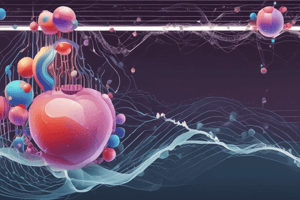Podcast
Questions and Answers
What is the characteristic of fatty acids containing double bonds?
What is the characteristic of fatty acids containing double bonds?
- They are always unsaturated
- They have a lower melting point (correct)
- They have a higher melting point
- They are always saturated
What type of fatty acid is Linolenic acid?
What type of fatty acid is Linolenic acid?
- Omega-9 fatty acid
- Omega-12 fatty acid
- Omega-6 fatty acid
- Omega-3 fatty acid (correct)
What is the configuration of the double bonds in fatty acids?
What is the configuration of the double bonds in fatty acids?
- Trans
- Unsaturated
- Saturated
- Cis (correct)
What are fatty acids that cannot be synthesized by the body called?
What are fatty acids that cannot be synthesized by the body called?
What is the shorthand representation of Palmitic acid?
What is the shorthand representation of Palmitic acid?
What is the symbol used to indicate the site of unsaturation in a fatty acid?
What is the symbol used to indicate the site of unsaturation in a fatty acid?
What is the designation of Palmitoleic acid?
What is the designation of Palmitoleic acid?
What are Linoleic acid and Linolenic acid examples of?
What are Linoleic acid and Linolenic acid examples of?
What is the characteristic of lipids in terms of solubility?
What is the characteristic of lipids in terms of solubility?
What is the energy value of 1 gram of fat?
What is the energy value of 1 gram of fat?
What is the function of lipids in terms of membrane structure?
What is the function of lipids in terms of membrane structure?
What is the characteristic of fatty acids in terms of their carbon chain?
What is the characteristic of fatty acids in terms of their carbon chain?
What is the term for fatty acids that contain no carbon-carbon double bonds?
What is the term for fatty acids that contain no carbon-carbon double bonds?
What is the role of lipids in the electron transport chain?
What is the role of lipids in the electron transport chain?
What is the characteristic of fatty acids in terms of their carboxylic acid group?
What is the characteristic of fatty acids in terms of their carboxylic acid group?
What is the source of fat-soluble vitamins?
What is the source of fat-soluble vitamins?
Flashcards are hidden until you start studying
Study Notes
Introduction to Lipids
- Lipids are hydrophobic, nonpolar molecules soluble in nonpolar solvents but insoluble in polar solvents like water.
- Lipids encompass fatty acids, triglycerides, steroids, and eicosanoids.
Functions of Lipids
- Lipids serve as a high-energy source, with 1 gram of fat providing 9 calories.
- Lipids are constituents of membrane structure and regulate membrane permeability.
- Lipids facilitate the absorption of fat-soluble vitamins (A, D, K, and E).
- Lipids act as cellular metabolic regulators (steroid hormones and prostaglandins).
- Phospholipids in inner mitochondrial membranes participate in the electron transport chain.
Fatty Acids
- Fatty acids contain a carboxylic acid group, making them polar, but their long hydrocarbon tail makes them nonpolar overall.
- Fatty acids typically contain between 12 and 20 carbon atoms, usually in even numbers.
- Saturated fatty acids have no carbon-carbon double bonds, while unsaturated fatty acids have double bonds, and polyunsaturated fatty acids (PUFAs) have multiple sites of unsaturation.
Properties of Fatty Acids
- Melting points of saturated fatty acids increase with the number of carbon atoms.
- Unsaturated fatty acids have lower melting points due to cis double bonds.
- Omega-3 fatty acids, like linolenic acid, are essential fatty acids.
Essential Fatty Acids
- Essential fatty acids (EFAs) cannot be synthesized by the body and must be obtained through the diet.
- EFAs are unsaturated fatty acids, including linoleic acid (18:2;9,12) and linolenic acid (18:3;9,12,15), as well as arachidonic acid (20:4;5,8,11,14).
Representation of Fatty Acids
- Fatty acids are represented by a shorthand notation: total number of carbon atoms, followed by the number of double bonds, and finally the position of double bonds starting from the carboxyl end.
Delta System
- The delta (Δ) system indicates the site of unsaturation in a fatty acid, with the number of the first carbon of the double bond relative to the carboxylic acid group (–COOH) designated as carbon 1.
Studying That Suits You
Use AI to generate personalized quizzes and flashcards to suit your learning preferences.



